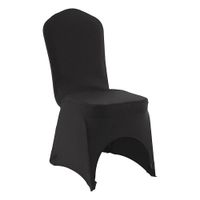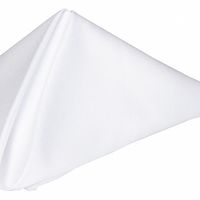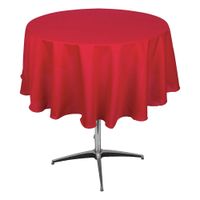Call +(254) 703 030 000 / 751 483 999 / 721 704 777
.....Read More
Frequently Asked Questions
What size tablecloth do I need for my table?
To determine the appropriate tablecloth size, follow these steps:
1. **Measure Your Table**:
- **Length and Width**: For rectangular or oval tables, measure the length and width. For round tables, measure the diameter.
- **Height**: Measure the height if you want a floor-length drop.
2. **Decide on the Drop Length**:
- **Standard Drop**: Typically 6-12 inches on each side.
- **Formal Drop**: 15 inches or more, often used for formal events.
- **Floor-Length**: Measure from the table edge to the floor for a full drop.
3. **Calculate Tablecloth Size**:
- **Rectangular/Oval Tables**: Add twice the desired drop to both the length and width. For example, for a 60x40 inch table with a 10-inch drop, the tablecloth should be 80x60 inches.
- **Round Tables**: Add twice the desired drop to the diameter. For a 50-inch diameter table with a 10-inch drop, the tablecloth should be 70 inches in diameter.
4. **Consider Table Extensions**: If your table has leaves or extensions, measure with them in place if you plan to use them.
5. **Check Standard Sizes**: Compare your calculated size with standard tablecloth sizes available in stores to find the closest match.
6. **Material and Style**: Choose a material and style that suits the occasion and complements your decor.
By following these steps, you can select the perfect tablecloth size for your table, ensuring a well-dressed table for any occasion.
How do I choose the right table skirt for my event?
1. **Event Type and Theme**: Consider the formality and theme of your event. For formal events like weddings or corporate functions, opt for elegant fabrics like satin or silk. For casual events, polyester or cotton might be more appropriate.
2. **Color Scheme**: Match the table skirt color with your event's color palette. Neutral colors like white, black, or beige are versatile, while bold colors can make a statement.
3. **Table Size and Shape**: Measure your tables to ensure the skirt fits properly. Skirts are available for round, rectangular, and square tables, so choose accordingly.
4. **Fabric Type**: Select a fabric that suits the event's ambiance. Satin and silk offer a luxurious look, while polyester is durable and easy to clean.
5. **Length and Drop**: Decide on the skirt length. Floor-length skirts provide a formal look, while shorter skirts can be used for casual settings. Ensure the drop covers the table legs completely.
6. **Attachment Method**: Choose between clip-on, Velcro, or sewn-in skirts based on ease of use and table type. Clip-on skirts are versatile, while Velcro offers a seamless look.
7. **Budget**: Determine your budget. High-end fabrics like silk are more expensive, while polyester is cost-effective.
8. **Rental vs. Purchase**: Decide whether to rent or buy. Renting is cost-effective for one-time events, while purchasing is better for frequent use.
9. **Customization**: Consider custom skirts for a unique touch, especially if you have specific design requirements.
10. **Supplier Reputation**: Choose a reputable supplier to ensure quality and timely delivery.
11. **Care and Maintenance**: Consider ease of cleaning and maintenance, especially for events with food and drinks.
12. **Environmental Impact**: Opt for eco-friendly materials if sustainability is a priority.
What materials are best for tablecloths and table skirts?
Cotton, polyester, linen, satin, and spandex are among the best materials for tablecloths and table skirts.
Cotton is a popular choice due to its natural feel, breathability, and ease of washing. It is ideal for casual settings and offers a variety of patterns and colors.
Polyester is favored for its durability, wrinkle resistance, and affordability. It is suitable for both casual and formal events and is easy to maintain.
Linen is a premium option known for its elegant appearance and texture. It is perfect for formal occasions but requires more care, as it wrinkles easily and may need ironing.
Satin provides a luxurious, glossy finish, making it ideal for weddings and upscale events. It drapes beautifully but can be more delicate and requires careful handling.
Spandex is a modern choice for table skirts, offering a snug fit and sleek look. It is stretchable, wrinkle-free, and easy to clean, making it suitable for contemporary and professional settings.
Each material has its unique advantages, and the choice depends on the event type, desired aesthetic, and maintenance preferences.
How do I properly care for and clean cloth napkins?
1. **Pre-Treatment**: Immediately after use, shake off any loose debris. For stains, blot (do not rub) with cold water or a stain remover. Treat stains as soon as possible to prevent setting.
2. **Sorting**: Separate napkins by color and fabric type. Wash whites, lights, and darks separately to prevent color bleeding.
3. **Washing**: Use a gentle detergent. For cotton or linen, wash in warm water. For delicate fabrics like silk, use cold water and a gentle cycle. Avoid fabric softeners as they can reduce absorbency.
4. **Drying**: Air drying is best to prevent shrinkage and maintain fabric integrity. If using a dryer, choose a low heat setting. Remove napkins while slightly damp to minimize wrinkles.
5. **Ironing**: Iron napkins while they are still slightly damp for best results. Use the appropriate heat setting for the fabric type. For cotton and linen, a high heat setting with steam is effective. For delicate fabrics, use a low heat setting.
6. **Storage**: Store napkins flat or folded neatly in a dry, cool place. Avoid overcrowding to prevent wrinkles.
7. **Regular Maintenance**: Regularly inspect napkins for stains or damage. Address issues promptly to extend their lifespan.
8. **Special Care**: For heirloom or delicate napkins, consider hand washing and air drying. Use a pressing cloth when ironing to protect the fabric.
9. **Eco-Friendly Tips**: Use eco-friendly detergents and avoid bleach. Consider line drying to save energy.
10. **Frequency**: Wash napkins after each use to maintain hygiene and appearance. Rotate napkins to ensure even wear.
By following these steps, you can maintain the quality and appearance of your cloth napkins, ensuring they last for many uses.
Can chair covers fit any type of chair?
Chair covers are designed to fit a variety of chair types, but not all covers will fit every chair. The fit depends on several factors, including the chair's shape, size, and design.
1. **Universal Fit Covers**: These are made from stretchy materials like spandex or polyester blends, allowing them to fit a wide range of chair shapes and sizes. They are ideal for standard banquet chairs, folding chairs, and some dining chairs.
2. **Custom Fit Covers**: These are tailored to specific chair models or styles, ensuring a snug fit. They are often used for uniquely shaped chairs or those with unusual dimensions.
3. **Chair Type Considerations**:
- **Banquet Chairs**: Typically have a standard size and shape, making them compatible with most universal fit covers.
- **Folding Chairs**: Generally fit well with universal covers, but the cover must accommodate the chair's folding mechanism.
- **Dining Chairs**: Vary widely in design, so it's important to measure the chair's dimensions and compare them with the cover's specifications.
- **Armchairs**: Require covers with specific allowances for armrests, which may not be available in universal fit options.
4. **Material and Design**: The material's elasticity and the cover's design (e.g., pleated, ruffled) can affect the fit. Stretchy materials offer more flexibility, while rigid fabrics may require precise measurements.
5. **Measurements**: Accurate measurements of the chair's height, width, and depth are crucial to ensure a proper fit, especially for non-standard chairs.
In summary, while many chair covers are versatile, not all will fit every chair type. It's essential to consider the chair's specific characteristics and the cover's design and material to ensure compatibility.
How do I prevent tablecloths from slipping off the table?
1. **Table Clips**: Use table clips to secure the tablecloth to the table. These are especially useful for outdoor settings where wind might be a factor.
2. **Non-Slip Mats**: Place a non-slip mat or liner between the table and the tablecloth. This creates friction and helps keep the cloth in place.
3. **Table Weights**: Attach table weights to the edges of the tablecloth. These can be decorative and add a touch of style while preventing the cloth from moving.
4. **Elasticized Tablecloths**: Use tablecloths with elastic edges that fit snugly around the table, similar to a fitted sheet.
5. **Double-Sided Tape or Velcro**: Apply double-sided tape or Velcro strips to the underside of the tablecloth and the table to hold it in place.
6. **Rubber Bands**: For smaller tables, wrap large rubber bands around the tablecloth and the table legs to secure it.
7. **Heavy Centerpieces**: Place heavy centerpieces or objects on the table to weigh down the tablecloth.
8. **Custom-Fit Tablecloths**: Consider having a tablecloth custom-made to fit your table perfectly, reducing the likelihood of slipping.
9. **Underlay**: Use a table pad or underlay beneath the tablecloth to add weight and grip.
10. **Tension Rods**: For tables with a lip or edge, use tension rods underneath to hold the tablecloth taut.
11. **Fabric Starch**: Apply fabric starch to the tablecloth to make it stiffer and less likely to move.
12. **Secure Corners**: Tie or pin the corners of the tablecloth to the table legs for added security.
Are there eco-friendly options for table linens and chair covers?
Yes, there are several eco-friendly options for table linens and chair covers.
1. **Organic Cotton**: Grown without harmful pesticides or synthetic fertilizers, organic cotton is a sustainable choice. It is biodegradable and has a lower environmental impact compared to conventional cotton.
2. **Linen**: Made from the flax plant, linen is a natural fiber that requires minimal water and pesticides. It is durable, biodegradable, and becomes softer with each wash.
3. **Hemp**: Hemp is a fast-growing plant that requires little water and no pesticides. Fabrics made from hemp are strong, durable, and biodegradable.
4. **Bamboo**: Bamboo grows rapidly and does not require pesticides. Bamboo fabric is soft, biodegradable, and has natural antibacterial properties.
5. **Recycled Polyester**: Made from recycled plastic bottles, this fabric reduces waste and energy consumption. It is durable and can be recycled again at the end of its life.
6. **Tencel/Lyocell**: Produced from sustainably sourced wood pulp, Tencel is biodegradable and manufactured using a closed-loop process that recycles water and solvents.
7. **Reclaimed Fabrics**: Using reclaimed or upcycled fabrics reduces waste by repurposing materials that would otherwise end up in landfills.
8. **Natural Dyes**: Opting for linens dyed with natural dyes reduces the environmental impact associated with synthetic dyes.
9. **Fair Trade Certified**: Choosing fair trade certified products ensures that the materials are sourced sustainably and that workers are paid fair wages.
10. **Local Artisans**: Supporting local artisans reduces the carbon footprint associated with transportation and supports sustainable practices.
These options not only minimize environmental impact but also often support ethical labor practices, making them a responsible choice for eco-conscious consumers.


